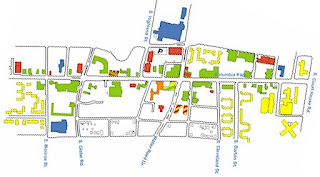
I love the idea of street cars running up and down Columbia Pike, increasing the traffic-carrying capacity of that important corridor in Arlington and Fairfax Counties. And I’m impressed by the plan to support the trolleys with appropriate adjustments to land use and urban design (see “
Street Cars and Zoning Codes.”) But I’m not real excited about the $40 million that the Northern Virginia Transportation Authority has air-dropped onto the project.
According to the
Connection newspapers, some members objected to the funding, which will “go towards the studying and design of the proposed streetcar,” on the grounds that the money could have paid for widening roads somewhere.
Ay yi yi. Where do I begin? If it can be demonstrated that an investment in street cars can provide more mobility and access than adding a couple of lane-miles of urban roadway, then, by all means, let’s go with the street cars! Only someone in the business of laying asphalt would have a problem with that. But the problem is, we don’t know which option is more cost effective.
Go to the Northern Virginia Transportation Authority
website and you’ll find a six-year
project list. That list will describe the project and provide some cost numbers. But the website does not make available any data required to compare the benefits of the projects in any meaningful way. Although the list includes a project score of obscure meaning — apparently some 18 prioritization criteria were used — the website does not provide that data. In sum, there is no transparency into the process used to rank the projects.
How much will the Columbia street car system cost? $40 million just for study and design? Holy smokes! That’s a lot of dineros. How much capacity will the trolleys add to the thoroughfare? How many passengers are expected to ride the trolleys? How much congestion will it relieve? What will be the ongoing costs of maintaining and operating the system? What is the return on public dollars invested — either in terms of improved safety or reduced traffic congestion?
Of course, precisely the same kinds of questions should be asked for other projects such as: Metro station access improvements, the Ashburn park ‘n ride lot, bike path improvements in Alexandria, widening of the Prince William County Parkway, intersection improvements on Chain Bridge Road, the municipal parking lot in Falls Church, the Rt. 28 grade separation overpass, and all the other recently approved projects.
Not only does there appear to be no way to rank projects by Return on Investment, there is no mechanism to coordinate the transportation improvements with changes to land use. (If the Columbia Pike streetcar system happens to be coordinated with land use in the corridor, that’s because Arlington County is one of the few jurisdictions in Virginia to take planning seriously, not because of any requirement of the NVTA.) No one is asking, if Project X is approved, what impact will that have on development and redevelopment in the area, and what impact will that have on subsequent traffic patterns? No one is asking, if Project Y is built, what changes to land use could leverage the benefits of that public investment? No one is asking, will Project Z contribute to the creation of communities that balance trips generated with transportation capacity?
To all appearances, the NVTA is simply doling out a lot of money — a little here, a little there — and taking great care to spread it all around the region so nobody can whine that “So-and-so got more money than we did.”
Despite these obvious deficiencies in the allocation of transportation funds, the Northern Virginia Transportation Alliance, representing 18 major business organizations, insists that the $300 million a year to be raised through newly enacted taxes and fees is not enough. At a minimum, the group recently resolved, the region requires $400 million a year.
All I can say is that if the business executives of Northern Virginia ran their enterprises the way they propose running government functions, Fairfax, Alexandria and Arlington County would resemble the Third World. Every successful business ranks major investment projects by ROI! Every successful business views asks if investments advance a larger strategic objective. But somehow it’s OK to ignore those fundamental business principles when it comes to investing in transportation infrastructure. Simply amazing.
Update: Kala Quintana, interim PIO for the transportation authority, responds in the comments section that the scoring process for projects was transparent during the compilation of the Transaction 2030 plan. The scoring criteria are spelled out here, and “NVTA is in the process of transferring all of the Tranaction 2030 info to the main NVTA site. We’re working as fast as we can!”
(Image cutline: Corridor map of Columbia Pike. Image credit: Arlington County.)
Related



